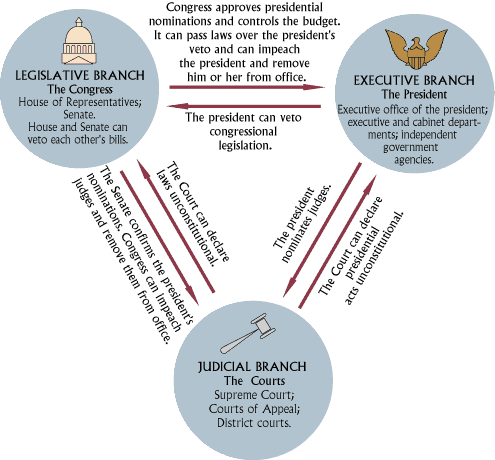|
Tilted Cat Head
Administrator
Location: Manhattan, NY
|
here's a more visual primer for you will... maybe this will help you a bit more understand how the checks and balances are defined and how they actually are intended to work as designed by the framers of the US Constituion.

Quote:
View: How does our system of checks and balances help protect our rights?
Source: socialstudieshelp.com
posted with the TFP thread generator
How does our system of checks and balances help protect our rights?
As we have already seen our Constitution is very much a reaction to the events that came before it. Our founding fathers had several goals, foremost among those goals was to avoid tyranny. In order to do this several different systems were set up to prevent the abuse of power. Federalism was one of these systems. Federalism was designed to balance the power of the national and State governments and thus limit the powers of the national government. Jefferson and others were convinced that state government was closer to the people and thus more democratic.
Another system that was developed was the system of checks and balances. Checks and balances, or the separation of powers, is based upon the philosophy of Baron de Montesquieau. In this system the government was to be divided into three branches of government, each branch having particular powers.

Legislative Branch - Makes the laws
Executive Branch - Enforces and carries out the laws.
Judicial Branch - Interprets the laws
Not only does each branch of the government have particular powers each branch has certain powers over the other branchs. This is done to keep them balanced and to prevent one branch form ever gaining too much power. For example:
--------------------------------------------------------------------------------
Congress may pass laws........but the President can veto them.
--------------------------------------------------------------------------------
The President can veto laws.......but Congress can override the veto with a 2/3 vote.
--------------------------------------------------------------------------------
The President and Congreess may agree on a law..........but the Supreme Court can declare a law unconsitutional.
--------------------------------------------------------------------------------
The President can appoint Judges and other government officials.......but Senate must approve them.
--------------------------------------------------------------------------------
Supreme Court judges have life terms.......but they can be impeached .
--------------------------------------------------------------------------------
As you can see there are many ways (there are many more than listed) that the Constitution balances power. Real life conflicts that test the system have occured throughout history. These checks and balances are used on a regular basis.
- After the Civil War President Andrew Johnson vetoed over 20 bills.
- After the Civil War Congress overrode overrode over 20 Presidential vetoes!
- In1987 President Ronald Reagan appointed Judge Robert Bork to the Supreme Court, his nomination was defeated.
- In 1935 and 1936 the Supreme Court declared the NIRA and then the AAA (two New Deal programs passed during the Roosevelt administration) unconstitutional.
- In 1918 Congress refused to ratify the Treaty of Versailles, a peace treaty ending World War I that President Wilson had worked very hard on.
There are thousands of examples of checks and balances at work. As we continue this year we will examine these and many more.
|
__________________
I don't care if you are black, white, purple, green, Chinese, Japanese, Korean, hippie, cop, bum, admin, user, English, Irish, French, Catholic, Protestant, Jewish, Buddhist, Muslim, indian, cowboy, tall, short, fat, skinny, emo, punk, mod, rocker, straight, gay, lesbian, jock, nerd, geek, Democrat, Republican, Libertarian, Independent, driver, pedestrian, or bicyclist, either you're an asshole or you're not.
|